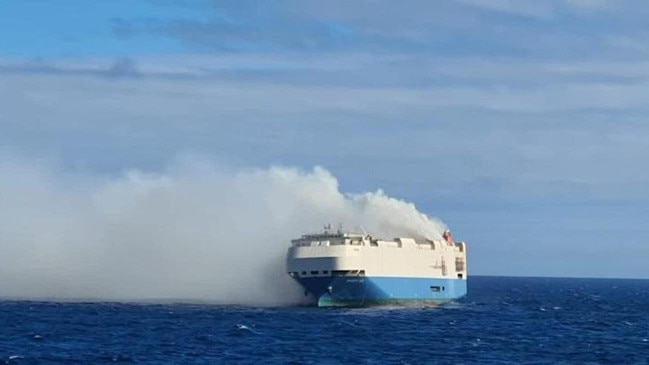Weather delays effort to steady burning ship carrying Porsche, Bentley, VW cars
The intensity of the fire has weakened, local authorities and the salvage company say, but the ship is still burning and is too hot to board.

Heavy tug boats reached the Felicity Ace, a merchant ship with a hold full of German luxury cars that has been drifting ablaze in the Atlantic for nearly a week, but bad weather delayed the arrival of other ships needed to steady the vessel and stop the blaze.
The intensity of the fire had weakened, local authorities and SMIT Salvage said, but the ship was still burning and too hot to board.
The fire also seemed to have spread inside the ship to below sea level, according to a Portuguese naval officer. Salvage crews working to get the ship under control spotted a fire in the machinery room, said Joao Manuel Mendes Cabecas, captain of the nearest Portuguese naval port on the island of Faial in the Azores. For now, the risk of ship’s fuel igniting is low because the tanks are built to withstand fires, he added.
“But if the fire isn’t controlled it can get to the fuel,” he said. “The biggest concern is making sure they can kill that fire.”
The 60,000-ton Felicity Ace was carrying around 4,000 cars from Germany to the U.S., including 1,100 Porsche sports cars and 189 superluxury Bentleys, the car makers said, which are all units of Volkswagen AG . The vessel caught fire last Wednesday, leading to the evacuation of the 22 crew members.
The vehicles represent only a small number of the nine million cars produced by the Volkswagen group each year, but the incident is the latest in a series of supply-chain setbacks hitting the global auto industry, which is still struggling to recover from the production bottlenecks caused by a shortage of components and disruptions during the Covid-19 pandemic.
The Felicity Ace, a cargo ship carrying thousands of cars including Porsches and Bentleys to the port of Davisville, R.I., caught fire last week and was adrift in the mid-Atlantic after the crew was evacuated. Burning electric vehicle batteries complicated efforts to battle the blaze. Photo: Portuguese Navy
The impact of the fire on Volkswagen’s earnings is likely to be negligible, analysts said. U.S. dealers say the cars will be replaced, but the fire has destroyed some of the most expensive vehicles consumers can buy, many of them made-to-order.
“For most people these are just expensive cars,” said Mike Sullivan, a Los Angeles-based Porsche dealer. “But these were really beautiful cars.”
Twenty vehicles on the Felicity Ace, valued at about $2.6 million, had been destined for Hennessy Porsche North Atlanta, said owner Peter Hennessy. None of them are electric models, he said.
Eighteen of the vehicles had already been purchased by customers, Mr. Hennessy said. Some are high-end Porsches built in limited numbers, including a 911 Turbo S priced at $272,000 and a $192,000 Cayenne Turbo GT, he said.
Porsche hasn’t confirmed whether those vehicles are lost, but the company told dealers that it has contingency plans to replace these orders in coming weeks as needed, Mr. Hennessy said. Normally the customer wait time for many models would be a year or longer, he said.
Mr. Hennessy said dealership staffers last week rushed to alert customers that their vehicles were in peril before they found out from Porsche’s online tracking system, named “Track Your Dream.”
“We wanted to alert as many customers as possible before they discovered their dream was floating off the Azores,” he said.
It isn’t clear yet how the fire started, but the large number of electric cars on the vessel raises questions about how EVs with lithium-ion batteries that can catch fire can be safely transported. The salvage company said burning electric car batteries could make the fire difficult to contain and particularly hard to extinguish.
For now, the Felicity Ace continues to drift further out to sea, said MOL Ship Management, the company that owns the operator of the ship.
Two firefighting tug boats with water cannons doused the ship’s exterior throughout the day, an effort the salvage crews call “barrier cooling,” which aims to lower the temperature of the external steel skin of the ship and weaken the intensity of the fire inside.
“The vessel is still very hot,” said a spokesman for Royal Boskalis Westminster NV, which owns SMIT Salvage. “We expect to have additional capacity in the next two days. The focus will then be—subject to smoke and temperature—to get onto the casualty.”
SMIT Salvage, which was celebrated last year for refloating the Ever Given, a container ship that got stuck in the Suez Canal, still doesn’t have equipment on the water to tie down the Felicity Ace and keep it from drifting further out to sea, where it could become more vulnerable to bad weather and rough seas. Two oceangoing tug boats en route to the ship have been delayed by bad weather.
Once additional ships arrive and the Felicity Ace has been cooled sufficiently to board, salvage crews will attempt to attach hauling cables to the cargo ship to stop it from drifting and regain control over the vessel, the Boskalis spokesman said.
A helicopter is scheduled to arrive later this week that would carry salvage crews onto the ship once it is cool enough to enter, the spokesman said.
The Wall Street Journal


